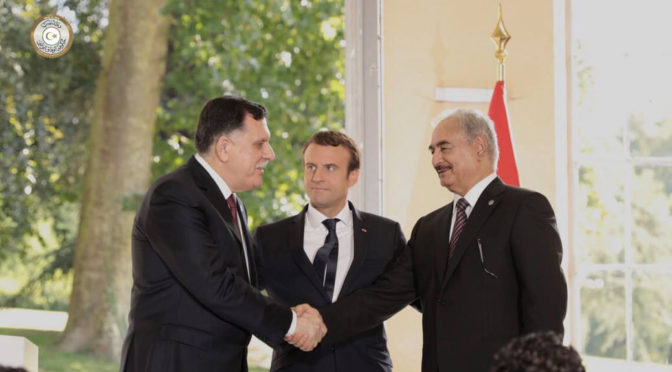Image: July Ceasefire posted
by Government of National Accord Facebook page,
25 July 2017
Having evaluated the likelihood for each scenario for the future of Libya (see detail here), we shall now present updated likelihoods that account for changes that have taken place since we began the evaluations. Because both intervention and spillover are already undoubtedly occurring in Libya, our scenarios are now considered sub-scenarios of Scenario 2: Intervention and spillover instead of independent scenarios. We shall then present the complete set of scenarios, with the updated likelihoods.
Executive Summary
Now that we have evaluated each scenario for the future of Libya, we organized them into a single graph that allows for a more accurate strategic picture. Our complete set of scenarios now reflects updated likelihoods that account for recent events on the ground. The ceasefire and subsequent dialogue between the COR and GNA, the various crises and strategic shifts in the Middle East that have affected the ability of external actors to intervene, and counter-migration efforts by Italy and Libyan tribes have notably affected the likelihood of several scenarios.
Based on the current realities and updated likelihoods, we found that continued civil war was the most likely outcome of peace talks (98%); continued war with a change in strategic terms was twice as likely to occur as a total victory (66%); and increased intervention was nearly 45% likely to occur, with no increased intervention slightly higher at more than 55%.
Full article 2110 words – approx. 5 pages
Notes: In the following article, we shall use the acronym COR for the Council of Representatives (nationalists), GNC for the General National Congress (Islamists), and GNA for the UN-backed Government of National Accord (unity government).
Editor’s note: To assess conflict and war, and thus when we refer to war or civil war, we are using the Heidelberg Institute for International Conflict Research (HIIK) dynamic scale for conflicts (Conflict Barometer 2016, pp.6-8). There may thus be discrepancy between the words we use and official statements and labelling. The latter are indeed decided for any political reasons, but do not necessarily aim at representing the reality on the ground.
Access for non-members or for your package is limited.
To continue reading, become a member of The Red (Team) Analysis Society.
If you are already a member, please login (don’t forget to refresh the page). You can access the page through my account, click on view in “My membership table” to access the list of the articles available to members only).
Although we have concluded our detailing of the scenarios for Libya’s future, we shall continue to monitor events on the ground and occasionally provide likelihood updates as needed.
Bibliography
Feature Photo: July Ceasefire posted by Government of National Accord Facebook page, 25 July 2017
Abdulkader Assad, “Haftar meets Italian Defense Minister in Rome,” The Libya Observer, September 27, 2017
Abdulkader Assad, “Presidential Council collapsing from the inside as three members reject Al-Sirraj’s decisions,” The Libya Observer, September 4, 2017
Abdulkader Assad, “With Italy’s aid, Libyan UN-proposed government pays militias money to block migrants routes,” The Libya Observer, August 30, 2017
Abdullah Ben Ibrahim, “Libyan Political Agreement amendment meeting kicks off in Tunisia,” The Libya Observer, September 26, 2017
Andrew Torchia, “Qatar growth sinks as oil sector stalls, sanctions cause minor damage,” Reuters, October 1, 2017
Barin Kayaoglu, “Turkish military sends anti-referendum message with exercises across border,” Al-Monitor, September 18, 2017
Declan Walsh and Jason Horowitz, “Italy, Going It Alone, Stalls the Flow of Migrants. But at What Cost?” The New York Times, September 17, 2017
Elvis Boh, “Libyan rival parties hold peace talks in Tunisia,” Africa News, September 26, 2017
“Ghwell said his fighters withdrew to prevent further damage in Tripoli,” Libya Herald, May 29, 2017
“Haftar in Italy to discuss terrorism and smuggling,” Middle East Monitor, September 27, 2017
Hani Amara, “French foreign minister in Libya to push peace deal,” Reuters, September 4, 2017
“HoR member Baira says Speaker is an obstacle,” Libyan Express, August 22, 2017
Housam Najjair, “High Council member calls for Swehli’s immediate resignation,” The Libya Observer, June 22, 2017
Ibrahim Ouf, “Cairo facing calls to increase Sinai military presence,” Middle East Online, September 17, 2017
“Igtet to announce new Libyan government by end of October,” Libyan Express, September 27, 2017
“IS militants control Wadi Al-Ahmar near Sirte,” Libyan Express, September 3, 2017
“Italian foreign ministry denies AP report about paying Libyan militias to block migrants,” Libyan Express, August 30, 2017
“Italy begins training Libyan navy and coastguard,” Middle East Monitor, September 19, 2017
“Italy restoring Libyan ships, training coast guard – Pinot,” ANSAmed, September 5, 2017
Jalel Harchaoui and Matthew Herbert, “Italy claims it’s found a solution to Europe’s migrant problem. Here’s why Italy’s wrong.” The Washington Post, September 26, 2017
Jamal Adel, “Qatrun Tebu brigade clamps down on southern border smuggling,” Libya Herald, September 11, 2017
“Kurdish referendum triggers retaliation from Iraq, Turkey,” CBS News, September 30, 2017
Lamine Ghanmi, “Libya’s strongman seeks national leadership without a vote,” Middle East Online, September 18, 2017
“Libya: EU Renews Sanctions for Six Months Against Obstructing Peace,” All Africa, September 28, 2017
“Libya groups start talks in Tunisia to launch new UN plan,” PressTV, September 26, 2017
“Libyan eastern so-called army spokesman: IS terrorists moving to northern Libya,” Libyan Express, September 4, 2017
“Libyan strongman forcing people to sign recommendation for him to become president,” Libyan Express, September 7, 2017
“Libya’s unity government suffers blow as four ministers resign,” Middle East Eye, July 1, 2016
“Libya’s wannabe president, Basit Igtet, starts getting likes across the country,” Libyan Express, September 12, 2017
Meryem Goktas and Mahmut Geldi, “Italian military mission arrives in Libya,” Anadolu Agency, August 3, 2017
Metin Gurcan, “Turkey adds to its critical deficit of military pilots,” Al-Monitor, September 4, 2017
Patrick Wintour, “Italian minister defends methods that led to 87% drop in migrants from Libya,” The Guardian, September 7, 2017
“’Positive signs after Libya peace talks,” DefenceWeb, September 7, 2017
“Pro-Ghwell forces halt advance on Tripoli after Serraj calls for international allies to attack,” Libya Herald, July 7, 2017
Raf Sanchez, “Libya rivals agree to ceasefire and elections after peace talks hosted by Emmanuel Macron,” The Telegraph, July 25, 2017
Ramadan Al Sherbini, “Financially strained, Qatar’s clout in Africa diminishes,” Gulf News, September 25, 2017
“Rival Libya government seeks international recognition,” The New Indian Express, September 17, 2017
Safa Alharathy, “MP Abu Shagur resigns from HoR,” The Libya Observer, August 28, 2017
Shabina S. Khatri, “Report: Qatar spends nearly $40 billion to support crisis-hit economy,” Doha News, September 15, 2017
“Southern border reported blockaded as Qatrun leader confirms “big” drop in migrants coming from Niger,” Libya Herald, September 7, 2017
Sudarsan Raghavan, “Egypt’s long, bloody fight against the Islamic State in Sinai is going nowhere,” The Washington Post, September 15, 2017
The Anti-ISIS Coalition, Eye on ISIS in Libya, May 30, 2017
“Thousands take to public squares in Libya to back up Igtet’s call for reform,” Libyan Express, September 25, 2017
“Turkey sends military vehicles, equipment to Syrian border: Anadolu,” Reuters, September 17, 2017







